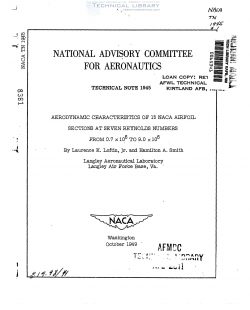naca-tn-1945
- Version
- 216 Downloads
- 7.39 MB File Size
- 1 File Count
- December 8, 2016 Create Date
- December 8, 2016 Last Updated
National Advisory Committee for Aeronautics, Technical Notes - Aerodynamic Characteristics of 15 NACA Airfoil Sections at Seven Reynolds Numbers

An investigation has been made of the, hm-dimensioml aerodynamic
characteristics of 15 NAGA airfoils at four Reynolds numbers
from 2.0 x 105 to 0.7 x 106. These data, together with those from
previous NACA papers ‘for the same airfoils at three Reynolds numbers
from 3.0 x 10° to 9.0 X 106, are presented. and analyzed in the present
paper. The airfoils investigated consisted. of 10 systematically varied.
NACA 6—series airfoils and. 5 airfoils of the NACA XL- and 5-digit series.
The NACA 6- -series airfoils had thickness ratios varying from 9
to 18 percent of the chord, design lift coefficients varying from 0
to O. 6, and. positions of minimum pressure on the basic thickness form
at zero lift varying from 30 to 60 percent of the chord. The NAGA 1+-
and 5- digit- series sections investigated. consisted. of the NACA 0012,
and. the NAGA ML- and. 230-series sections of l2-percent and lS—percent
thickness. The tests were made for both smooth and rough surface
conditions and also included the determination of the effectiveness of
the different airfoils at various Reynolds numbers when equipped with
split flaps.
The results of the investigation indicate that the drag coefficient
at the design lift coefficient and. the maximum lift coefficient are the
important aerodynamic characteristics which are most affected by
variations in the Reynolds number between 9.0 x lO6 and. 0.7 X 106. For
each of the 15 airfoils in both the smooth and. rough surface conditions,
the drag coefficient at design lift increased as the Reynolds number
was lowered from 9.0 x 105 to 0.7 x 106. For the smooth NAGA 6-series
airfoils the magnitude of this increase became larger with increasing
airfoil thickness and with rearward movement of the position of minimum
pressure on the basic thickness form at zero lift. In the rough surface
condition and at the lower Reynolds numbers in the smooth surface
condition, the saving in minimum drag to be derived from the use of
NAGA 6- -series as compared with NASA 5—digit- series airfoil sections
disappears.
| File | Action |
|---|---|
| naca-tn-1945 Aerodynamic Characteristics of 15 NACA Airfoil Sections at Seven Reynolds Numbers from.pdf | Download |
Comment On This Post